Tourism has reached an all-time high in Long Beach, with 2016 being its “best year ever,” according to the Long Beach Area Convention & Visitors Bureau (CVB). And the greater the tourism, the greater the economic impact. The CVB estimates that in 2015 more than 6.8 million people visited the city for conventions, meetings, major attractions, festivals and annual special events.
Around 330 conventions and meetings with nearly 507,000 attendees have been held in the city this year, according to the CVB. This equaled 212,804 room nights, exceeding the annual goal by 12,804. However, the impact of conventions goes well beyond hotel room figures.
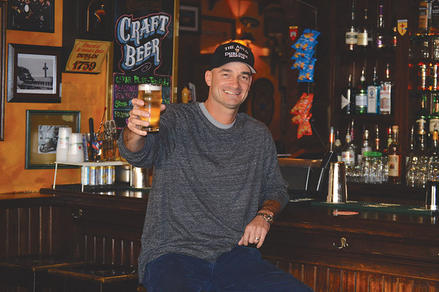
Eric Johnson, co-owner of the Auld Dubliner, said its proximity to the convention center and the customers they would gain as a result was a primary factor when he and his business partner, David Copley, decided to purchase the location on South Pine Avenue. (Photograph by the Business Journal’s Larry Duncan)
“Convention attendees usually are representing a company or an organization. Therefore, they travel with a corporate credit card. And, therefore, they want to take in the flavor of the city, and they want to enjoy the restaurants, and they want to enjoy the nightlife,” Steve Goodling, president and CEO of the CVB, said. “There’s less inhibition to spend. That’s one of the reasons that conventions are so dynamic, because it’s not attached as much to your personal income as it is to your budget.”
Businesses in close proximity to the convention center, such as the Auld Dubliner, benefit greatly when conventioneers decide to explore the town. Eric Johnson, co-owner of the Dubliner, said 25% to 30% of his business at the Irish pub and restaurant located across the street from the convention center is a direct result of conventions.
Johnson said the added density helps fill what are typically off-times at the pub – lunch and early evening. He added that some conventions are better for business than others, depending on the schedule of events. A loosely scheduled convention may give attendees more time to venture out into the city for lunch or dinner, rather than more strictly scheduled ones that provide meals at designated times.
“It’s definitely something we considered when we were selecting a location,” Johnson said. “We like The Pike. We like downtown. But the proximity to the convention center is definitely a primary factor in why we chose to put it in that South Pine location.”
DDR Corp., the property management company for The Pike Outlets, works with the CVB to provide conventioneers with coupon booklets for stores and restaurants on their property. Lauren Provence, marketing coordinator for The Pike, said retailers and restaurants definitely see an increase in foot traffic and sales when a convention is in town.
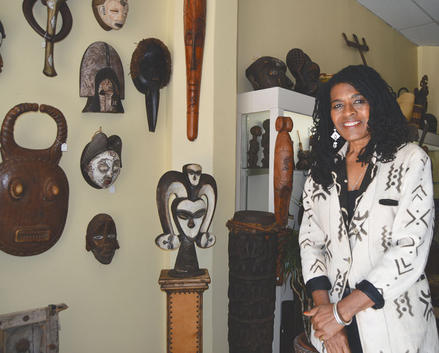
Maxie Viltz, owner of Village Treasures, a gift shop and boutique in Downtown Long Beach that focuses on African art and clothing, said tourists are her best customers, many of whom are in town for conventions. (Photograph by the Business Journal’s Larry Duncan)
“The Pike Outlets is fortunate to be located directly across Pine Avenue from the convention center. The Pike is a member of the convention and visitors bureau . . . [and] participates in expos at the convention center when appropriate, such as the Grand Prix and Long Beach Marathon, which contributes to the overall brand awareness of the shopping center.”
Debra Fixen, property manager for Shoreline Village, said her shops and restaurants also see an uptick in business when conventions are in town. Last year, Fixen said her tenants enjoyed a 17% increase in overall sales. This year, however, with increased convention and tourism activity, she said overall business is up 22%.
Shoreline Village is home to several iconic Long Beach locations, such as Parkers’ Lighthouse, the original Yard House restaurant and Queen Mary Couture. Fixen explained that the management company is a member of the CVB and that she encourages all of her tenants to become members as well.
“It’s affected the sales, and in addition, it also exposes more people to Long Beach as a destination,” Fixen said. “The tourists like one-of-a-kind gifts and Long Beach souvenirs and the restaurants – it’s all about the waterfront dining.”
Retailers within prominent complexes are not the only beneficiaries of conventions in the city. Small independent shops in the downtown and surrounding areas also thrive off of the business they receive from conventioneers. Kimberly Latham, owner of Anneise, a boutique in the East Village, said conventions drive her business.
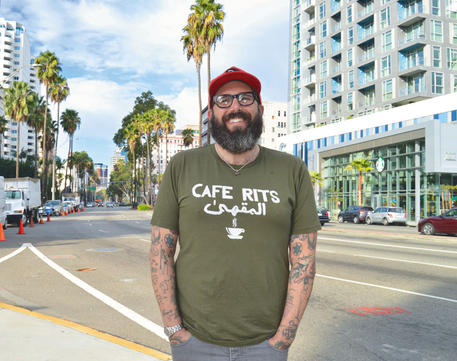
The extreme diversity in Long Beach is one of the reasons music festivals and other special events are so successful in the city, according to Jon Halperin, talent buyer for the Music Tastes Good festival. (Photograph by the Business Journal’s Larry Duncan)
Latham explained that, because of the size of her business and her budget, she is not currently a member of the CVB. However, she acknowledges the CVB’s work in promoting the city and bringing conventions and tourists.
“I always talk to my customers. I’m always, like, ‘Oh, what brings you to town?’ And that’s when I know whether they’re in for a convention or not,” Latham said. “I would say maybe 40% of my business is tourists who are here, a lot of them for conventions.”
Being located between hotels, Latham said people walking to and from the convention center or other parts of downtown from where they are staying really adds to her foot traffic. Maxie Viltz, owner of Village Treasures, a gift shop and boutique that focuses on African art and clothing, said she sees similar patterns of conventioneers and other tourists stumbling upon her shop when walking to their hotel or car parked nearby.
Viltz said that she will regularly have a convention attendee visit her shop and say they are going to tell others at the convention to visit the store. This, mixed with some loyal locals, keeps the doors of Village Treasures open. And Viltz said she hopes business continues to improve.
“Tourists have been my best customers for the most part,” Viltz said. “I’m a member of the convention and visitors bureau, so I try to keep up with what events are coming to town and so forth. Hopefully, people are starting to see my postcards that have information about the business.”
Some businesses, such as Caught in the Moment Photography, experience the benefits of conventions a little differently. Nearing their 17th year in business, Salvador and Lana Farfan quickly discovered that they wanted their photography business to focus on conventions. In fact, Lana estimates that 60% of the company’s business is convention related.
For years, the pair have been working with the CVB, which recommends Caught in the Moment to clients. Through working so many conventions of all types – some that are in Long Beach annually and some that are in town every couple of years on a rotating schedule – the Farfans have built relationships with many event organizers.
Nowadays, it’s not uncommon for Caught in the Moment to be hired by event organizers for conventions out of state after having worked together at a convention in Long Beach. “In other cities, they bring us with them because they know the quality of our product and also the personality and attitude,” Sal said.
“So not only do we get that business for the next year but we also get to see a new place and stretch our creative muscle and photograph that convention in different cities,” Lana added. “The CVB was the best thing we ever joined as a company, not only for the connections and the added business for our company but for the great relationships we’ve built. We’ve made a lot of lifelong friends through the CVB. . . . It definitely goes a layer deeper than the business relationship.”
Auld Dubliner’s Johnson said that he thinks the CVB does a fantastic job at promoting not just the convention center, but the downtown area and Long Beach in general as a destination. Not only do the numbers of conventions per year speak to this, according to Johnson, but the number of repeat conventions that come back year after year.
“It seems to be getting better and better,” Johnson said. “We’d like to see more and more. And we’d like to see the convention center expanded so we can get larger conventions in.”
Special Events
Aside from conventions, Long Beach is host to many large-scale, and sometimes international, special events. The Toyota Grand Prix of Long Beach, an international event which celebrated its 42nd year in April, for example, had an estimated 182,000 attendees over three days, according to race officials. Long Beach Pride, with a weekend of activities, frequently achieves around 80,000 attendees per year, according to Pride officials.
Last year, the City of Long Beach Bureau of Special Events and Filming issued 373 permits for special events on city property, according to Tasha Day, bureau manager.
“If you’re doing something big like Grand Prix, that’s like every hotel room in the city booked,” Day said. “That’s at least five days of every restaurant on Pine Avenue filled. They eat, sleep and drink here. The economic impact is pretty high.”
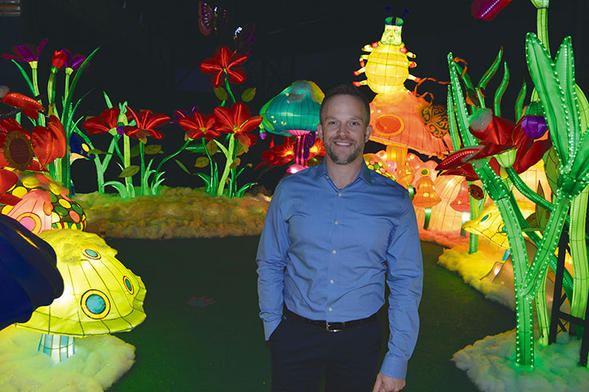
Steve Sheldon, director of events and entertainment at the Queen Mary, shows off the re-creation of the caterpillar scene from Lewis Carroll’s “Alice In Wonderland” with a wintery twist. It is part of the Queen Mary’s CHILL event Alice In Winterland interactive experience, which runs through January 8. (Photograph by the Business Journal’s Larry Duncan)
Second only to the Grand Prix, the Long Beach Marathon’s economic impact is also substantial. Bob Seagren, CEO of Run Racing, which is the marathon organizer, said the last economic impact report for the event was conducted after its 25th anniversary seven years ago. Seagren explained that the event brought $12.5 million in revenue to Long Beach alone and another $12 million to the surrounding area, numbers that he believes have increased since.
The last seven years have also seen the number of marathon participants exceeding 20,000 for all events. Seagren said the event requires about 2,000 volunteers to operate and brings about 75,000 spectators, based on the national marathon attendance average. However, the marathon does not only have an economic impact on Long Beach businesses; nonprofits also benefit greatly from the event.
“We have a lot of charities that benefit. We’re somewhere between $300,000 to $600,000 raised for various charities every year. And we try to bring in as many local, Long Beach-based charities as we can, but some are national in scope.”
The Queen Mary has been home to numerous special events since being relocated to Long Beach in 1967. From expensive and elegant New Year’s Eve and 4th of July parties with fireworks to hot, grungy music festivals, the ship is a seasoned veteran in the special events business.
Dark Harbor, the spooky event around Halloween, and CHILL, the winter and holiday-themed event, keep the Queen Mary staff and seasonal employees busy from September to the new year. Steve Sheldon, director of events and entertainment at the Queen Mary, said around 500 seasonal workers are hired for each event and estimates that 50% are Long Beach locals.
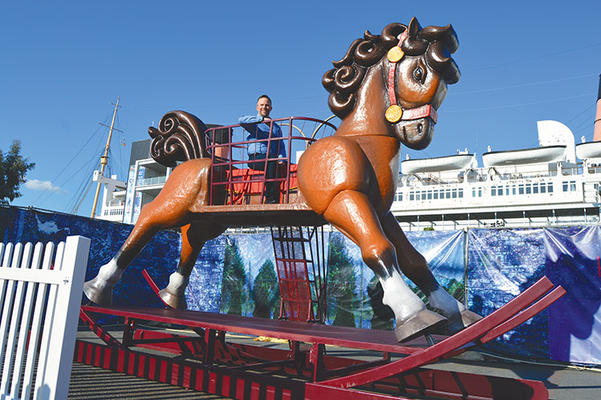
Steve Sheldon, director of events and entertainment at the Queen Mary, sits atop what he claims is the “World’s Largest Rocking Horse.” The 15-foot-tall, 24-foot-long, 8-foot-wide rocking horse can accommodate four people at a time and is free for those attending the ship’s CHILL event. CHILL runs through January 8 and includes ice skating, ice tubing, the North Pole Village and live entertainment. (Photograph by the Business Journal’s Larry Duncan)
Sheldon explained that these two events bring about 320,000 visitors to the Queen Mary each year and generate more than $15 million annually. He added that revenue does not take into account the money those visitors spend on hotels, restaurants, parking, retail and attractions around the city.
“One of the reasons that we, here at the Queen Mary, have focused so intently on building and developing our event program is that we believe very strongly in the residual impact that events have for us as an attraction, and also for the city as a whole,” Sheldon said. “The more that we develop live entertainment and reasons for people to come to the Queen Mary and to Long Beach, the more awareness is raised about the activities and attractions and restaurants and amenities that we have here in our city.”
This year saw the introduction of several special events that were able to showcase the city in new ways, including ComplexCon and Music Tastes Good – events that attracted first-time visitors to the city.
Aaron Levant, senior vice president of Reed Exhibitions US, the organizers of ComplexCon, began conducting business in Long Beach with his first Agenda trade show nearly six years ago. Since then, Agenda has taken place at the Long Beach Convention Center every January and July, with more than 12,000 attendees from 49 states and 60 countries ready to show off the latest fashions and styles.
“Between the hotel rooms that are booked, the money that is spent at local restaurants, bars, on the show floor, concessions, parking, all of the above – even if you want to get into all the labor that’s used on the show, all the rentals, everything – the impact is significant,” Levant said.
The inaugural ComplexCon in November attracted around 30,000 people, according to Levant. He said next year he expects attendance to increase to a minimum of 40,000 people, adding that he hopes to expand the footprint of the event by utilizing more venues around the city.
“[With] something like ComplexCon, our aim in the future is to make it something like South by Southwest in Austin, Texas, where it really becomes a citywide event – taking over all the venues, whether they be officially sanctioned events or non-official events,” Levant said. “We really want that to be something that, when you step foot in the city, you know that ComplexCon is going on, and it affects the whole thing and is a downtown takeover.”
Music Tastes Good, the three-day music festival that made its debut in September, brought thousands of music and food lovers to the city. Jon Halperin, the talent buyer for the event, said visitors came from around the country to see acts like the Specials, the Melvins, Warpaint, De La Soul and Iron & Wine.
The festival closed down streets in the East Village, but businesses were given the option to remain open during the festival. And they did.
“They were packed – especially the restaurants,” Halperin said. “What I heard was from friends who were going in and having drinks at these places, or even band members who were going in, and saying that it was packed and that they had a great time and that they were so happy that these places were open. You could go into a proper bar or restaurant and order the drinks at the same cost it would be any other day and have a wider selection.”
Halperin said the best part about Long Beach, the reason festivals and other special events work so well here, is that it is composed of every socioeconomic bracket, every ethnicity, every sexual orientation, every religion – and everyone just lives together. He said that atmosphere, along with the general vibe and the city’s beauty, makes it a great destination.
Being a resident of Long Beach, Halperin acknowledges that large-scale special events can be an inconvenience to those living nearby. He said events like the Grand Prix and the marathon can be tricky when they close down major streets downtown, and inconvenient when he has to wait an extra 20 minutes for food due to long lines filled with tourists.
“But you just turn a blind eye because the good it’s doing the city and the amount of people it’s bringing out to see this city outweigh not being able to move my car for a couple hours in the morning,” Halperin said. “I think you’d be hard-pressed to find somebody who disagreed. Who would say it doesn’t have a great financial impact?”
So despite the occasional inconvenience, Halperin hopes to see more festivals and events in the city because they help drive local businesses. He explained that these types of events have a long-term effect that goes much deeper than people visiting for the couple days the event is occurring – an idea that the CVB shares.
“The great thing about special events is they bring people into the city who normally wouldn’t come to the city on their own,” Goodling said. “It’s a chance for the city to showcase itself and encourage these new attendees to come back to the city beyond the special event that they came for. Special events add to the flavor of a city so that there’s always something fun, new and different going on. And special events keep a city vibrant.”
